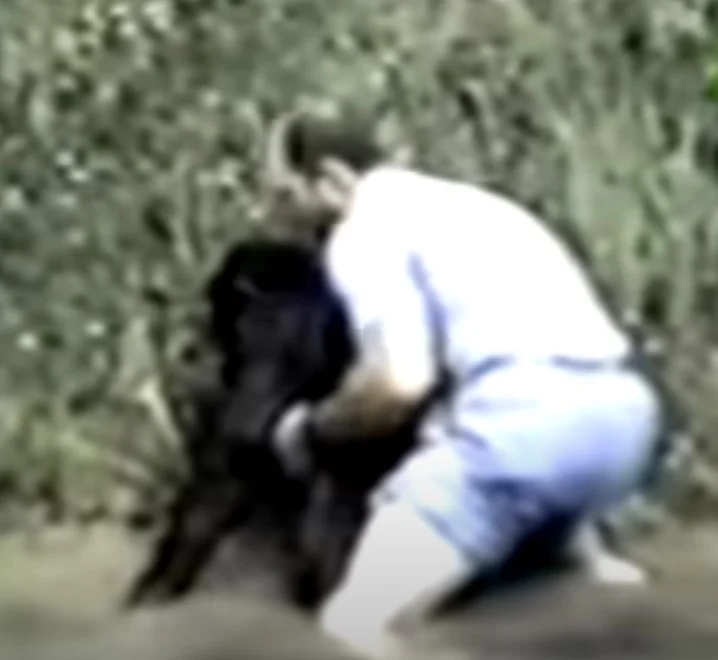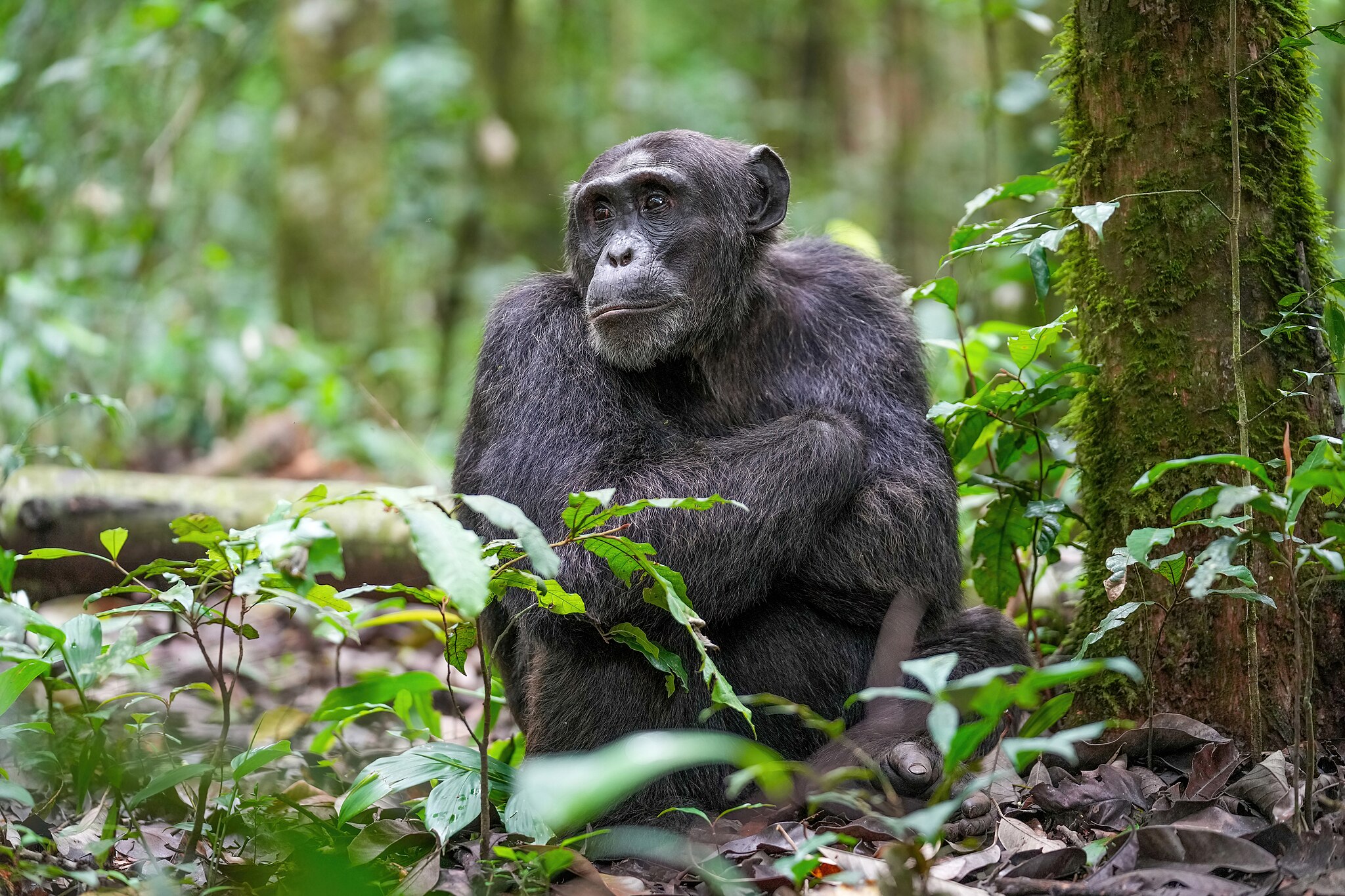A truck driver’s selfless act at a Michigan zoo became one of the most remarkable moments of human compassion ever captured.

The Day Courage Defied Caution
On a quiet day in August 1990, Rick Swope, a 33-year-old truck driver from Canton, Michigan, visited the Detroit Zoo with his wife and three children. What began as a family outing quickly turned into a scene of chaos and disbelief.
A scuffle broke out between two male chimpanzees inside their enclosure. One of them, a young male named Jo-Jo, fled the fight but slipped into a water-filled moat that surrounded the exhibit.
Chimpanzees cannot swim. Within moments, Jo-Jo was thrashing helplessly, his head bobbing above and below the surface.
“Everyone in the whole place was just standing around watching this monkey drown,” Swope later told reporters. “When he went down the second time, I knew I had to do something.”
Ignoring the shouted warnings from zoo staff, Rick climbed the wall of the enclosure and dove into the murky water. The crowd gasped, both in fear for him and awe at his bravery.

A Battle in the Water
At first, Swope struggled to find the chimp in the muddy moat. He reached out, but Jo-Jo slipped beneath the surface again. Determined, Swope dove deeper, emerging moments later with the 200-pound animal in his arms.
It was a dangerous move. Chimpanzees are five times stronger than humans, and other chimps in the enclosure could have attacked at any moment.
But something remarkable happened. Instead of reacting with aggression, Jo-Jo appeared calm, almost aware of his rescuer’s intent.
“He was looking at me,” Swope recalled. “I think he knew what was going on.”
Rick dragged the chimp to the shore and gently pushed him onto the grass. As Jo-Jo coughed up water and began to breathe again, Rick quickly climbed back out to safety, drenched and shaking, but alive.
When Humanity Meets Instinct
Swope’s daring act drew immediate national attention. Television crews and newspapers across the country featured his story, calling him “the man who risked his life for a chimpanzee.”
Among those moved by the story was renowned primatologist Dr. Jane Goodall, who later spoke about the incident at the Woodrow Wilson International Center for Scholars. She shared what Swope told her institute’s director:
“I happened to look into his eyes, and it was like looking into the eyes of a man, and the message was, ‘Won’t anybody help me?’”
That moment of eye contact, a brief yet profound connection, symbolized the empathy that bridges species. For Goodall, it was a powerful reminder of the shared emotional depth between humans and great apes.
Jo-Jo’s Story: A Life of Survival
Little is known about Jo-Jo’s life after the rescue. Like many captive chimpanzees, he had endured hardship before arriving at the zoo. Born in Africa, he was taken from the wild after poachers killed his mother, a common tragedy for primates sold into captivity.
While records of Jo-Jo’s later years remain limited, Swope’s actions gave him another chance at life, one that could easily have ended that day in the moat.
The Detroit Zoo later took steps to improve the safety of its enclosures, ensuring that such incidents would never happen again.
The Science of Empathy: Why We Help
Acts like Swope’s aren’t just stories of heroism, they’re windows into what psychologists call “empathic concern.” It’s the instinctive urge to help others, even at personal risk.
According to a 2013 study published in Frontiers in Human Neuroscience, observing distress in others triggers neural circuits in the human brain associated with self-preservation and compassion. In other words, we are wired to respond to suffering, sometimes before logic has time to intervene.
In Swope’s case, that wiring manifested in its purest form: spontaneous, selfless action.

How One Moment Inspired a Movement
Over the years, Rick Swope’s story has continued to circulate online, shared across forums, documentaries, and animal advocacy pages.
For animal rights groups, his bravery underscores a larger message: that empathy should extend beyond humanity. Organizations like the Jane Goodall Institute and the Humane Society of the United States have used similar examples to advocate for better treatment of animals in captivity.
Even decades later, the video footage of Swope’s rescue remains a striking testament to moral courage, the kind that asks nothing in return.
Lessons in Courage and Compassion
What makes Rick Swope’s story so powerful isn’t just what he did, it’s what he represents.
He didn’t wait for permission. He didn’t question whether it was safe. In those few seconds, he simply acted on what his heart told him was right.
This instinct, to protect, to connect, is something deeply human. It reminds us that compassion doesn’t always come from training or moral reasoning. Sometimes, it’s just who we are.
As Jane Goodall put it:
“If you see that look with your eyes, and you feel it in your heart, you have to jump in and try to help.”
A Legacy That Lives On
Rick Swope lived the rest of his life quietly, rarely speaking publicly about the event. But his act of bravery continues to be remembered by animal lovers, conservationists, and everyday people around the world.
His story endures as proof that empathy is action, not theory. It’s what happens when humanity transcends fear.
“Courage is not the absence of fear,” as one Detroit newspaper later wrote, “but the decision that something else is more important than fear.”
Watch the Full Video below:
Featured Image from: © Giles Laurent, gileslaurent.com, License CC BY-SA, CC BY-SA 4.0, via Wikimedia Commons

